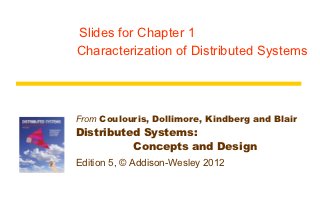
Chapter 1 slides
- 1. Slides for Chapter 1 Characterization of Distributed Systems From Coulouris, Dollimore, Kindberg and Blair Distributed Systems: Concepts and Design Edition 5, © Addison-Wesley 2012
- 2. Figure 1.1 (see book for the full text) Selected application domains and associated networked applications Finance and commerce eCommerce e.g. Amazon and eBay, PayPal, online banking and trading The information society Web information and search engines, ebooks, Wikipedia; social networking: Facebook and MySpace. Creative industries and online gaming, music and film in the home, user- entertainment generated content, e.g. YouTube, Flickr Healthcare health informatics, on online patient records, monitoring patients Education e-learning, virtual learning environments; distance learning Transport and logistics GPS in route finding systems, map services: Google Maps, Google Earth Science The Grid as an enabling technology for collaboration between scientists Environmental management sensor technology to monitor earthquakes, floods or tsunamis Instructor’s Guide for Coulouris, Dollimore, Kindberg and Blair, Distributed Systems: Concepts and Design Edn. 5 © Pearson Education 2012 2
- 3. Figure 1.2 An example financial trading system Instructor’s Guide for Coulouris, Dollimore, Kindberg and Blair, Distributed Systems: Concepts and Design Edn. 5 © Pearson Education 2012 3
- 4. Figure 1.3 A typical portion of the Internet intranet ☎ ☎ ☎ ISP ☎ backbone satellite link desktop computer: server: network link: Instructor’s Guide for Coulouris, Dollimore, Kindberg and Blair, Distributed Systems: Concepts and Design Edn. 5 © Pearson Education 2012
- 5. Figure 1.4 Portable and handheld devices in a distributed system Instructor’s Guide for Coulouris, Dollimore, Kindberg and Blair, Distributed Systems: Concepts and Design Edn. 5 © Pearson Education 2012
- 6. Figure 1.5 Cloud computing Instructor’s Guide for Coulouris, Dollimore, Kindberg and Blair, Distributed Systems: Concepts and Design Edn. 5 © Pearson Education 2012 6
- 7. Figure 1.6 Growth of the Internet (computers and web servers) Date Computers Web servers Percentage 1993, July 1,776,000 130 0.008 1995, July 6,642,000 23,500 0.4 1997, July 19,540,000 1,203,096 6 1999, July 56,218,000 6,598,697 12 2001, July 125,888,197 31,299,592 25 2003, July ~200,000,000 42,298,371 21 2005, July 353,284,187 67,571,581 19 Instructor’s Guide for Coulouris, Dollimore, Kindberg and Blair, Distributed Systems: Concepts and Design Edn. 5 © Pearson Education 2012
- 8. Section 1.5.7 Transparencies Access transparency: enables local and remote resources to be accessed using identical operations. Location transparency: enables resources to be accessed without knowledge of their physical or network location (for example, which building or IP address). Concurrency transparency: enables several processes to operate concurrently using shared resources without interference between them. Replication transparency: enables multiple instances of resources to be used to increase reliability and performance without knowledge of the replicas by users or application programmers. Failure transparency: enables the concealment of faults, allowing users and application programs to complete their tasks despite the failure of hardware or software components. Mobility transparency: allows the movement of resources and clients within a system without affecting the operation of users or programs. Performance transparency: allows the system to be reconfigured to improve performance as loads vary. Scaling transparency: allows the system and applications to expand in scale without change to the system structure or the application algorithms. Instructor’s Guide for Coulouris, Dollimore, Kindberg and Blair, Distributed Systems: Concepts and Design Edn. 5 © Pearson Education 2012
- 9. Figure 1.7 Web servers and web browsers Web servers Browsers http://www.google.comlsearch?q=obama www.google.com www.cdk5.net Internet http://www.cdk5.net/ www.w3c.org File system of http://www.w3.org/standards/faq.html#conformance www.w3c.org standards faq.html Instructor’s Guide for Coulouris, Dollimore, Kindberg and Blair, Distributed Systems: Concepts and Design Edn. 5 © Pearson Education 2012